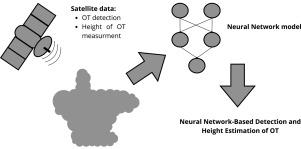从可见卫星频道自动检测超调顶及其特性
IF 4.4
2区 地球科学
Q1 METEOROLOGY & ATMOSPHERIC SCIENCES
引用次数: 0
摘要
超冲顶(OTs)是对流风暴强度的信息指标,在气象分析中得到广泛应用。本文提出了一种基于卷积神经网络的可见光卫星图像OT检测和OT高度估计的自动算法。这些模型是在一个广泛的OT数据集上进行训练和验证的,该数据集包括欧洲大约10,000例人工检测的病例。通过MSG地球同步卫星上的SEVIRI仪器的高分辨率可见(HRV)通道识别出这些地点,并根据图像中它们的阴影长度确定其高度。传统的OT检测方法主要依赖于热红外通道中冷特征的识别,而我们的方法利用训练数据集提供的OT阴影长度的地面真值数据,从可见通道中提取信息。在上午和下午,当阴影可见时,所提出的模型检测到ot的概率达到97%,估计其高度的平均误差为0.25 km。一旦将该模型应用于提高空间分辨率的极地和新一代地球静止卫星,其性能有望进一步改善。本文章由计算机程序翻译,如有差异,请以英文原文为准。

Automatic detection of overshooting tops and their properties from visible satellite channels
Overshooting tops (OTs) are informative indicators of convective storm intensity and are widely utilized in meteorological analyses. This study presents an automated algorithm for OT detection and OT height estimation using convolutional neural networks applied to visible satellite imagery. The models are trained and validated on an extensive OT dataset comprising approximately 10,000 manually detected cases over Europe. The OTs were identified from high-resolution visible (HRV) channel of the SEVIRI instrument on board the MSG geostationary satellite, with the heights determined from the length of their shadows in the imagery. While conventional OT detection methods primarily rely on the identification of cold features in thermal infrared channels, our approach extracts information from visible channels, leveraging the ground truth data on OT shadow length provided by the training dataset. In the morning and afternoon hours, when the shadows are visible, the proposed models detect OTs with a probability of detection reaching 97% and estimate their height with an average error of 0.25 km. The performance is expected to further improve once the model is applied to polar and new generation geostationary satellites with increased spatial resolution.
求助全文
通过发布文献求助,成功后即可免费获取论文全文。
去求助
来源期刊

Atmospheric Research
地学-气象与大气科学
CiteScore
9.40
自引率
10.90%
发文量
460
审稿时长
47 days
期刊介绍:
The journal publishes scientific papers (research papers, review articles, letters and notes) dealing with the part of the atmosphere where meteorological events occur. Attention is given to all processes extending from the earth surface to the tropopause, but special emphasis continues to be devoted to the physics of clouds, mesoscale meteorology and air pollution, i.e. atmospheric aerosols; microphysical processes; cloud dynamics and thermodynamics; numerical simulation, climatology, climate change and weather modification.
 求助内容:
求助内容: 应助结果提醒方式:
应助结果提醒方式:


